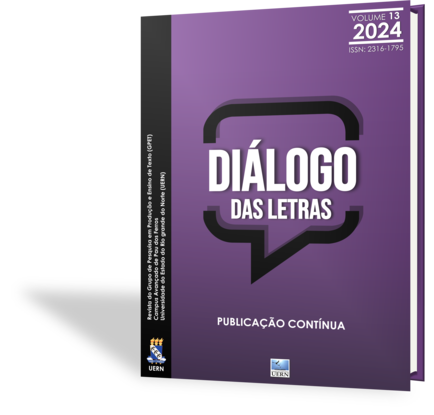The violent communication of violence: critical discourse analysis on the Lázaro Barbosa case
The violent communication of violence: critical discourse analysis on the Lázaro Barbosa case
DOI:
https://doi.org/10.22297/2316-17952024v13e02411Keywords:
Violence, Journalistic speech, Critical discourse analysisAbstract
Nowadays, information circulates instantly and impacts the ideological and discursive formation of citizens. The problem is that the production and distribution of this information is still controlled by large companies, which, in their search for market dominance, can reproduce violent speeches. In this sense, this research aimed to investigate, in the light of Critical Discourse Analysis (CDA), the journalistic discourse on the case of criminal Lázaro Barbosa. Convicted and declared a fugitive, Lázaro was the target of a major police operation in the region between Goiás and Brasília – an episode that received wide journalistic coverage in the country. Critical Discourse Theory is the core of this research, specifically from the dialectical-relational approach whose main author is Norman Fairclough. The methodology was built with the support of the Meaning of Words and Intertextuality categories, mobilized in favor of Actional Meaning and Representational Meaning, respectively. The corpus consisted of six articles published at the end of the first half of 2021, the time when the analyzed event took place. It was noticed that both the lexical choices present in the construction of the news and the voices included by journalists in the texts were responsible for placing Lázaro in a superhuman place, treating him in an animalistic way in order to strengthen the discriminatory discourses present in society.
Downloads
References
ACOSTA, M. Del P. T.; RESENDE, V. de M. Justiçamento em rede: direitos humanos e efeito midiático. Revista Bakhtiniana, São Paulo, v. 14, n. 01, p. 7-27, 2019. Disponível em: https://revistas.pucsp.br/index.php/bakhtiniana/article/view/35719. Acesso em: 14 dez. 2022.
BESSA, D.; SATO, D. T. B. Categorias de Análise. In: BATISTA JR, J. R. L.; SATO, D. T. B.; MELO, I. F. de (org.) Análise de Discurso Crítica para linguistas e não-linguistas. São Paulo: Parábola, 2018. p. 124-157.
CARVALHO, D. W.; FREIRE, M. T.; G. VILLAR. Mídia e violência: um olhar sobre o Brasil. Revista Panamericana de Salud Pública, v. 31, n. 5, p. 435–438, 2012. Disponível em: https://iris.paho.org/handle/10665.2/9322. Acesso em: 04 jan. 2022.
CHOULIARAKI, L.; FAIRCLOUGH, N. Discourse in late modernity: rethinking critical discourse analysis. Edinburgh: Edinburgh University Press, 1999.
FAIRCLOUGH, N. Discurso e Mudança Social. 2. ed. Tradução de Izabel Magalhães. Brasília: UNB, 2001.
GIDDENS, A. As consequências da modernidade. Tradução de Raul Fiker. São Paulo: Editora UNESP, 1991.
HALL, S. et.al. A produção social das notícias: o mugging nos media. In: TRAQUINA, N. Jornalismo: questões, teorias e estórias. Lisboa: Veja, 1993. p. 112-133.
LAGES, N. Estrutura da Notícia. 5. ed. São Paulo: Editora Ática, 2005.
MAGALHÃES, I. Introdução à Análise de Discurso Crítica. Revista Delta, v. 21, n. 03, Edição Especial, p. 1-9, 2005. Disponível em: https://revistas.pucsp.br/delta/article/view/37759/0 . Acesso em: 23 jan. 2022.
MARTA, L. Violência velada: discurso da massa Robotizada. In: MODENA, M. R. (org.). Conceitos e formas de violência. Caxias do Sul, RS: Educs, 2016. p. 57-174.
SÓLIO, M. B. Violência: um discurso que a mídia cala. In: CONGRESSO DE CIÊNCIAS DA COMUNICAÇÃO NA REGIÃO SUL, 11, Novo Hamburgo, 2010. Anais... Novo Hamburgo: Intercom, 2010. p.1-15. Disponível em: http://www.intercom.org.br/papers/regionais/sul2010/resumos/R20-1179-1.pdf. Acesso em: 23 jan.2022.
SOUSA, J. P. Elementos de jornalismo impresso. Florianópolis: Letras Contemporâneas, 2005.
RAMIREZ, G. Psicopatia: o que é e como identificar um psicopata. Revista Tua Saúde, 2021. Disponível em: https://minutosaudavel.com.br/psicopatia/. Acesso em: 25 jan. 2022.
RESENDE, V. de M.; RAMALHO, V. C. V. S. Análise de Discurso Crítica, do modelo tridimensional à articulação entre práticas: implicações teórico-metodológicas. Revista Linguagem em (Dis)curso, Tubarão, v. 5, n.1, p. 185-207, jul./dez. 2004. Disponível em: https://portaldeperiodicos.animaeducacao.com.br/index.php/Linguagem_Discurso/article/view/307/323. Acesso em: 03 fev. 2022.
RIBEIRO, D. Pequeno Manual Antirracista. São Paulo: Companhia das letras, 2019.
TUZZO, S. A.; CIRINO, J. A. F. Cobertura do caso Serial Killer de Goiânia: o espelho virou lupa? Revista Esferas – a violência discursiva, v. 02, n. 07, p. 37-46, 2016. DOI: https://doi.org/10.31501/esf.v2i7.5709. Disponível em: https://portalrevistas.ucb.br/index.php/esf/article/view/5709. Acesso em: 10 jan. 2022.
VAN DIJK, T. A. Discurso, Notícia e Ideologia: estudos na análise crítica do discurso. Tradução de Zara Pinto-Coelho. Ribeirão: Edições Húmus, 2017.
VERNER, A. Valores-Notícia e critérios de noticiabilidade na web: a presença da audiência e a necessidade de uma (re)discussão teórica. In: SEMINÁRIO DE INICIAÇÃO CIENTÍFICA PARA PUBLICAÇÕES EM JORNALISMO, Paraná, 2019. Anais... Paraná: UFPR, 2019. p. 1-14. Disponível em: https://institucional.unisecal.edu.br/wp-content/uploads/2019/08/PubliJor_Afonso_Verner.pdf. Acesso em: 04 jan.2022.
Downloads
Published
How to Cite
Issue
Section
License
Copyright (c) 2024 Diálogo das Letras

This work is licensed under a Creative Commons Attribution 4.0 International License.
A Diálogo das Letras não se responsabiliza por conceitos e opiniões emitidos pelos autores, tampouco manifesta, necessariamente, concordância com posições assumidas nos textos publicados. Além disso, os dados e a exatidão das referências citadas no trabalho são de inteira responsabilidade do(s) autor(es). Ao submeterem seus trabalhos, os autores concordam que os direitos autorais referentes a cada texto estão sendo cedidos para a revista Diálogo das Letras; ainda concordam que assumem as responsabilidades legais relativas às informações emitidas.


















